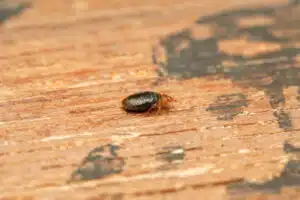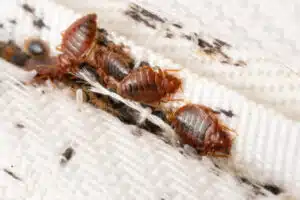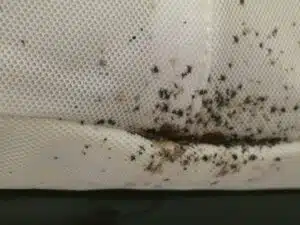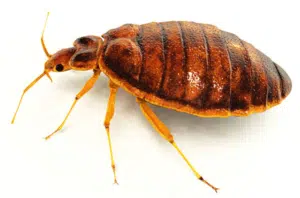Pharaoh Ants
The ant Monomorium pharaonis is commonly known as the Pharaoh ant. The name possibly arises from its mistaken belief that it was one of Egypt’s plagues ( Peacock et al. 1950 ). This common household pest can be found all over and carries an unfortunate distinction for being among one of the toughest pests to control. In this blog post, we’ll discuss some more about this species and how to get rid of them.
Characteristics of Pharaoh Ants
Appearance: They’re about 2 mm long. Their bodies are light yellow with red and black markings on their abdomen.
Life Cycle: The Pharaoh ant has a life cycle that takes about 38 days from egg to adult. They have multiple queens that live for an average of 4-12 months, and workers only survive ten weeks in the colony before dying off or being replaced by new ants. The male pharaoh dies soon after mating.
Female pharaoh ants can lay 400 or more eggs in their lifetime. They lay eggs per batch, and most lay 10-12 eggs in the early days of egg production.
Habitat: Pharaoh ants are found in warm, humid environments and are commonly found in homes and businesses. The pharaoh ant is one of the most commonly seen ants in homes. This type builds nests anywhere from walls and cabinet voids, behind baseboards or refrigerator insulation, curtain rods, folds on clothes or sheets, and other undisturbed places. Their colony will scatter if disturbed, and this makes treatment more difficult.
Diet – Pharaoh ants are generalists when it comes to their diet and will feed on almost anything. They’re especially fond of sweets but also eat proteins found in other insects.
What Causes a Pharaoh Ants Infestation?
Pharaoh ants are small, but an infestation can be a serious problem. It can also be a problem in the house, restaurants, and office buildings where food is being handled. They are known to carry diseases like salmonella, staphylococcus, and clostridium and transmit more than 12 infectious organisms.
Pharaoh ants are attracted to moisture, so areas that are damp or have high humidity are more likely to have an infestation. In addition, they often invade homes, restaurants, and other businesses in search of food.
The infestation spread through the building’s service ducts, plumbing, and voids. The ants forage for water and food where condensation has occurred. The ants can survive for prolonged in low temperatures where the workers continue to forage for food.
Can Pharaoh Ants Bite?
The Pharaoh ant has pincer-like jaws and can bite, leaving a welt that lasts for hours; much like the bites of fleas or mosquitoes. However, the ant’s jaws are not strong enough to break through human skin. As a result, Pharaoh ants are more of a nuisance than a danger because of their ability to spread disease.
Signs of Pharaoh Infestation
Pharaoh ants love to nest behind walls, appliances, and floors. They’re usually found foraging throughout your home, especially near kitchen areas with more food sources like trash cans or pantry shelves. It could be an infestation if you see these amber-colored creatures all over!
Prevention and Control
Pharaoh ants are difficult to control and eliminate. However, there are things that you can do to prevent them:
- Seal all cracks and crevices around your home, especially entry points like doors and windows. This will help to keep them from getting inside in the first place.
- Keep your home clean and free of food debris: This will help eliminate potential food sources that might attract them into your home.
- Keep food in airtight containers and clean up any spills or crumbs immediately: This will help to keep food from being out in the open where ants can easily find and get to it.
- Eliminate water sources and use a humidifier indoor: Keep counters clean and dry, and mop up spills immediately. A humidifier can help keep the air dry, which ants don’t like.
If you have an infestation, the best way to get rid of Pharaoh ants is to call a professional pest control company. Do-it-yourself methods are not usually effective because Pharaoh ants will keep coming back. A professional can identify where the ants are coming from and treat the problem at the source. They will also be able to provide you with tips on how to keep ants from coming back in the future.
Related Articles

Tick vs. Bed Bugs: Differences and Similarities
Understanding the differences between two common blood-sucking pests, ticks and bed bugs, is important. We want to make sure you know exactly what kind of pests you’re dealing with,

Where Do Bed Bugs Come From, and How to Prevent Them? A Guide for Salt Lake Residents
Bed bugs can be a major nuisance and cause various physical and emotional problems, including skin irritation, anxiety, and sleep disturbances. In Salt Lake City, bed bugs are a growing concern, especially in apartment buildings, hotels, and other high-density living spaces. But where do bed bugs come from, and how can you prevent them from infesting your home or property?

Are All the Tiny Black Bugs in My Bed Bed Bugs?
Sleeping is one of the things that we look forward to after a very long day. We recharge ourselves by sleeping by the end of the night to be refreshed the next day. But we can be disturbed even during our sleep by pesky pests crawling and hiding where we sleep. That’s terrifying, right? Pests that are known to annoy us during our sleep are bed bugs. They are usually found where humans and other pets sleep. Bed bugs can be almost anywhere in the world – even in your Saltlake home! They can be annoying because they suck your blood and leave you with an itch and bumps in the infected area. So blood attracts them, even the blood of other animals. Therefore, you should conduct bed bug removal if you have them. If you find bugs on your beds, you might think they are bed bugs. But are they?

Can Bed Bugs Live in Your Car?
Bed bugs are small, flat, and oval-shaped insects that feed on the blood of humans and animals. During the day, bed bugs hide in cracks and crevices around beds, furniture, and baseboards. You can also find them in mattresses, bed frames, blankets, carpets, and other fabric items throughout your home. While it is possible for bed bugs to infest your car, they’re less likely to do so than inside a house or other structure.

How to Find Bed Bugs in Your Home
Bed bugs are small, blood-sucking that feed on human and animal blood. They belong to the family Cimicidae, contain over 100 species, and have been around for millions of years.

Can Bed Bugs Jump?
Bed bugs are a common household pest that can be difficult to get rid of. These tiny insects can live in any crevice or crack in your home and feed on blood.
